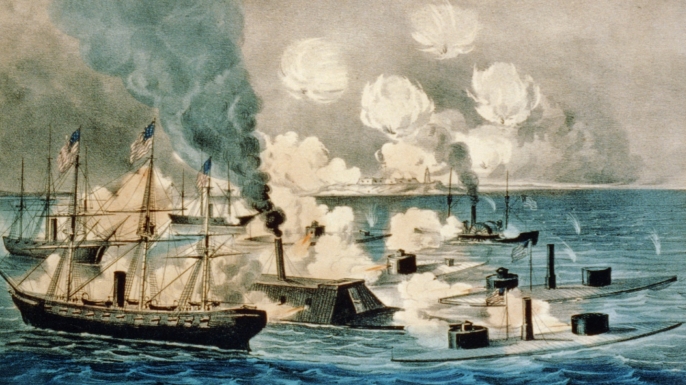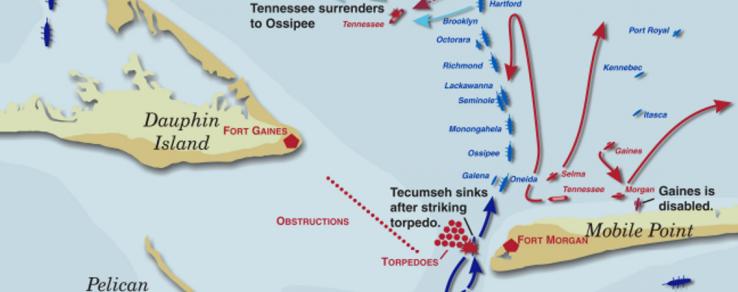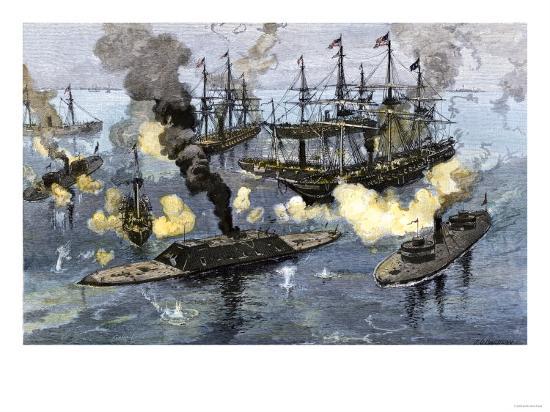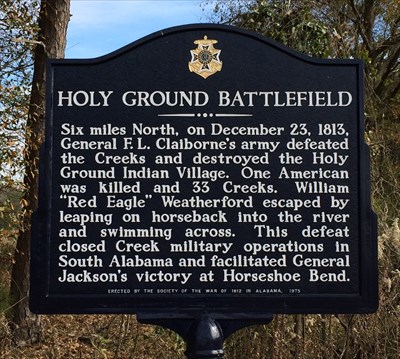The Battle of Mobile Bay Was the Last Naval Battle of the Civil War
The Battle of Mobile Bay was the last major naval battle of the Civil War and inspired the now famous saying “Damn the Torpedoes, Full Speed Ahead.
The victory by the Union forces led to the closing of Port of Mobile, which was considered to be the strongest of all the Confederate ports.
With the war entering into its fourth year in 1864, the Confederate’s fight for independence was still very hopeful and alive.
The agriculture trade was extremely healthy, and the southern ports and cities were thriving, despite a Union blockade.
However, Union Admiral David Glasgow Farragut was about to change all of that.
 The Battle of Mobile Bay
The Battle of Mobile BayThe Battle of Mobile Bay and the City
Both the City and Mobile Bay at the time was technically under the command of Major General Dabney Maury, and the site of the department headquarters, but he was not present during the famous battle.
Instead, the local command was entrusted to Brigadier General Richard Page.
There were three forts that protected the Bay: Fort Morgan, Fort Gaines, and Fort Powell.
Fort Morgan was a masonry structure that was built in 1834 and had 46 mounted guns and a garrison of about 600 soldiers.
Directly across the channel located on Dauphin Island was Fort Gaines, which had 26 guns and over 600 soldiers.
Fort Powell was located at the western end of the bay, and was a smaller fort with 18 guns, and a much smaller military with only 140 soldiers.
Mobile Bay is a natural harbor that is formed by the meeting of the Mobile and Tensaw rivers and is deep enough to accommodate ocean going vessels.
Early in the beginning of the Civil war, the Confederates made the decision not to defend the entire coastline, but instead focus on some key ports and harbors.
Once the loss of New Orleans occurred in 1862, their major focus turned to Mobile Bay.
Preparations for the Battle of Mobile Bay
 The Map of the Battle of Mobile Bay
The Map of the Battle of Mobile BayThe Confederate Torpedo Bureau, which was directed by Major General Gabriel Rains, made several unique preparations in preparing for the Battle of Mobile Bay.
He made plans to plant 67 “torpedoes”, referred to as naval mines, across the entrance of the bay.
He left a gap on the eastern side of the channel, so the blockade runners and other friendly vessels could safely enter and leave the harbor.
However, the minefield area was marked by buoys, which the Union navy fully understood.
They understood that the purpose of the torpedoes was not to sink enemy ships, but rather to steer them close to Fort Morgan, where the guns located there could launch their attacks.
In the meantime, the Confederate Navy worked on improving their defense, and built three small gunboats that were stationed at the Bay.
They included the CSS Selma, which carried four guns, the CSS Morgan, which had six guns, as well as the CSS Gains, also with six guns.
The also had the CSS Tennessee, an ironclad ram ship, and was an imposing figure because of her armor.
Launched before her machinery and guns were fully in place, the CSS Tennessee, on May 18, 1864, finally entered in the lower portion of the Bay.
The Tennessee was the only armored vessel the Confederate Navy had at the time, although they had plans for others.
The Battle of Mobile Bay
 The Surrender of the CSS Tennessee
The Surrender of the CSS TennesseeThe actual Battle of Mobile Bay took place on August 1864 and would end up being the last major naval engagement of the Civil War.
The Union commanders fully understood that any type of an infantry assault against this well protected City and Port would be a disaster, so they laid the plans to capture the Bay first.
The Union Naval fleet was under the command of Rear Admiral David G. Farragut, and his plans were very simple.
He planned to storm past the Forts into the Bay, directly engage the Confederate fleet, neutralize the Forts, and take possession of Mobile Bay.
Farragut had a fleet of 18 ships that included gunboats, sloops, as well as ironclads, and had little worry about the Confederates small gunboats.
However, he was worried about the CSS Tennessee.
To direct attention away from his main assault, Rear Admiral Farragut ordered 2,000 infantry troops to start to assail Dauphin Island, and then march onto Fort Gaines on August 3rd.
The Battle of Mobile Bay began early on the morning of August 5th, 1864, when the Confederates began to open fire from Fort Morgan on the advancing Union artillery.
The Confederates gained an early victory, when the ironclad Union Naval ship the USS Tecumseh, hit one of the torpedoes, and sank with all 94 of her sailors.
However, this was when Admiral Farragut, who was on the USS Hartford, made the famous saying “Damn the Torpedoes, Full Speed Ahead”.
It did not take long for the Union forces to fully neutralize the small Confederate gunboats, leaving only the CSS Tennessee as their only threat.
The Tennessee bravely fought 14 of the Unions’ wooden vessels, but at 9:35 a.m., it fired off its last shot.
The Union navy hammered the Tennessee, jamming shut four of her 10 port shutters, and totally destroyed the smokestack and steering chains.
At 10:00 a.m., the Tennessee and her 190-man crew surrendered to the Union Navy.
With the surrender, Admiral Farragut had accomplished what many thought was impossible, as he raced passed the Forts, navigated through all of the mines, and captured the confederate's most powerful ship.
The Union Navy suffered 315 casualties compared to the 32 suffered by the Confederates, and the Union had made a huge impact.
However, they still had to capture Fort Morgan and Fort Gaines to declare a total victory, and the infantry and navy then combined forces.
On August 8th at 9:30 a.m., the Confederate commander Col. Charles Anderson surrendered Fort Gaines, but Brig. General Richard Page stood firm at Fort Morgan.
Finally, after very heavy attacks for several days, on August 22nd, he surrendered Fort Morgan, ending the official Battle of Mobile Bay.
The city of Mobile remained under Confederate control until the final days of the war.
On March 24, 1865, the remnants under the command of Maj. General Dabney Maury evacuated, and then surrendered the city.
To this day there are still a number of Civil War era shipwrecks from this famous battle, which remain in the bay.
They include the American Diver, the CSS Gaines, the CSS Huntsville, the USS Tecumseh, and the CSS Tuscaloosa.
References
http://www.encyclopediaofalabama.org/article/h-1257
The Military History Of Alabama

Alabama Gift Store
Numerous Items for You and Your Family to Enjoy
See it here at the Gift Store
Copyright 2019-2023 Alabamabackroads.com
All Rights Reserved


















